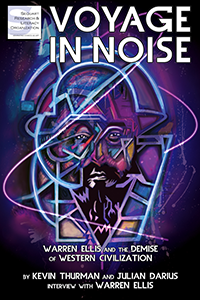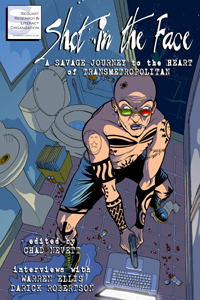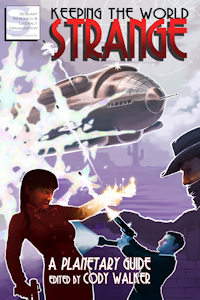The American comic book industry, as an economic institution, is doing terribly. Artistically, however, this will be remembered as a fairly good period. Many mainstream titles are selling less than 20,000 copies; a few even sell less than 10,000.
DC’s general approach has been to flood the market with product, eking out its meager profits over and over with the exception of its few major sellers. This strategy is hardly limited to DC; rather, it is one of the ironies of the market that, as it performs poorly, it publishes more than ever, both in terms of numbers and variety. DC in particular specializes in variety, including numerous imprints: Vertigo, the rarely-used Paradox Press, WildStorm, a couple creator-owned WildStorm lines, and America’s Best Comics.
Marvel, meanwhile, had greatly transformed and sells fewer titles than DC at higher volume.
Dark Horse Comics sells little but comic books of Star Wars and the (even more) insipid Buffy, the Vampire Slayer.
CrossGen has gained market share in a relatively quick amount of time. Unfortunately, almost all of this remains concerned with the super-hero genre, and, while that genre is certainly a worthy one, the monopolization of an art form by any one genre is equally certainly a sorry state of affairs.
Vertigo
We traffic in ghosts. The Vertigo line, sprang from glorious things and once known for producing new glorious things, now seems a shell of its former self. At the dawn of 2002, it has two series that sprang from Neil Gaiman’s The Sandman: (1) Lucifer and (2) The Sandman Presents (the second actually being a series of monthly mini-series and specials). It is as if NBC created The Seinfeld Family in the wake of Seinfeld‘s demise, leaving us to watch a show full of minor characters, a Soup Nazi special that, while not without some minor memorable elements enjoyable for themselves, leaves that bittersweet feeling of a party held over the graves of absent friends. A reference to Lucifer losing his wings reminds us of the brilliant The Sandman #23, of Kelley Jones’s artwork with its rolling folds in every robe, of Dream’s face in shock as he learns of Lucifer’s abdication.
Hellblazer, the last survivor of the six original Vertigo titles, does well, though its joys are here and there, leaving a feeling that nothing amounts to anything overmuch. It too traffics in the dead, recalling Alan Moore’s Swamp Thing from which it sprang more directly than did all of DC’s “mature readers” material. It even recalls Rick Veitch’s Swamp Thing run and Jamie Delano’s work on (mostly the early) Hellblazer, but this is bittersweet because those of us who know such genealogies also remember Veitch leaving the title (and all of DC) due to editorial interference, leading to a fall from grace, a monarchical line severed, as the promised land of Neil Gaiman and Jamie Delano’s collaboration which would have followed Veitch never materialized. We may also remember Warren Ellis’s resignation, due to editorial censorship, from Hellblazer after most of a year of quite memorable work that seemed a promise of a new promised land. These are sad thoughts with little to do with the quite poor Swamp Thing revival that was mercifully put to sleep or the generally good, and occasionally really great, work of Brian Azzarello on the present Hellblazer. But Azzarello’s odd work on Hellblazer constitutes a solid regime in a country once much greater, a respectable feat after that nation’s years of relative poverty but hardly the golden age one still feels upon picking up and rereading Moore’s Swamp Thing work — which takes our suspicion of its fading over time, of it being bound to the horror genre, and explodes them every time, like encountering again an old friend who our memory seeks to betray.
And then there’s Hunter: The Age of Magic, the continuation of Gaiman’s structurally tight The Books of Magic mini-series and the meandering series that previously continued it. The only real consolation is that Harry Potter, that billion-dollar industry of poor writing and corruption of children through distraction, borrowed from The Books of Magic. But this is no more a consolation than knowing that the great hit The Matrix borrowed from Grant Morrison’s brilliant The Invisibles (a revolutionary Vertigo title of old) or that the international controversy over Kevin Smith’s Dogma owed a great part to Smith’s fusion of aesthetics from Matt Wagner’s Mage, ideas from Garth Ennis’s Preacher (a highly original and amusing, but ultimately irrelevant, Vertigo title of old), and miscellaneous thoughts from a hundred other comic books. Not that there’s any popular awareness of these facts, though Americans do know comics influenced the plot-less special effects opus called X-Men.
Vertigo’s other regular offerings include 100 Bullets (which has justifiably accrued critical attention for both its writing and its art), American Century, Outlaw Nation (soon to be cancelled despite the involvement of Jamie Delano), The Crusades, and Codename: Knockout (a tongue-in-cheek series about a sexy woman / espionage agent). Of course, there are also the occasional mini-series, the most recent of which is Grip: The Strange World of Men, created by Gilbert Hernandez — one of the Hernandez brothers of Love and Rockets fame, work that intelligent people like and that can easily be admired visually but that is riddled with both breaks in style and tone (attempting to provide pseudo-realistic narrative but frequently breaking that tone) and a profoundly disturbing deep hatred of men (and I don’t mean the depiction of violence against men while women are protected, like Ennis’s Preacher, but rather the routine humiliation of men, depiction of their stupidity, and the central depiction of women as acceptable sluts who “get it” both emotionally and intellectually, as if there were no contradictions present). The line’s clear stand-out is Transmetropolitan, written (and co-owned with the penciller) by Warren Ellis. Good things certainly still come out from Vertigo, but 2001 was hardly a stellar example.
DC and WildStorm
Like the problems with DC’s main line, much of Vertigo’s malaise could be solved if the real writers and artists of the industry — as opposed to the hacks — were simply told to create virtually anything they wanted. Grant Morrison was wasted on JLA, his proposals rejected as “too much, too soon.” His proposal, with Mark Millar, Mark Waid, and Tom Peyer, to renovate Superman was — like Alan Moore’s proposed crossover, Twilight, fifteen years before — rejected. This is a clear case of a corporation in the business of producing art and putting marketing stratagems over art. But of course, Superman, for example, is not a character featured in DC Comics. He was that 60 years ago, but quickly he became a mass-media campaign, an icon to be exploited, so much a logo that he was featured in the DC Bullet, a corporate logo. His is a never-ending blitz not for justice but sales. His corpus is comprised of television series and refrigerator magnets, movies and lunchboxes — all of which can be re-released in perpetuity. He is Mickey Mouse for teenagers. And a script that messes with his origins or has him kissing another man, let alone murdering people, cannot be tolerated. Disney, after all, has to bury all of those racist cartoons featuring Mickey cheering as he guns down the Japs.
As art, Superman is dead. But the idea of a superman, of a powerful being with powers who derives from the Siegel-Shuster model, is alive and well. The best superman stories do not feature Superman at all: they feature Captain Marvel (published under the name Shazam! due to Marvel Comics and its lawyers), Mr. Majestic, Apollo of The Authority, or — better yet – Miracleman (né Marvelman) or Rick Veitch’s Maximortal.
For quite some time, DC had a reputation as being the creators’ friend. And there is no question that it led the way artistically throughout the 1990s. This was, of course, a result of its abuse of creators in the 1980s, leading to the departure of Alan Moore (and, to a lesser, extent, Frank Miller). Watchmen and Miller’s work on Batman changed the industry, giving us the first really adult super-heroes (Moore’s earlier work on Marvelman, V for Vendetta, and prior DC work not included). This abuse of creators extended to the censorship of Rick Veitch’s infamous Swamp Thing issue in which Swamp Thing, traveling through time, was to meet Jesus Christ; the issue reportedly had passed the editors and been penciled by Michael Zulli before the higher-ups at DC pulled the plug, causing Veitch to resign. In fact, Veitch, who had succeeded Moore (and done, incidentally, a remarkably good Superman story), had only three issues or so after that to go and was supposed to be succeeded himself by Jamie Delano (who was writing Hellblazer at the time) and none other than Neil Gaiman (then early in his work on The Sandman). The two would have alternated turns on the title, but they pulled out over the censorship of Veitch, thus ending the monarchy, as it were, that had reigned on the title and descended from Moore. The title spun into a creative tailspin until Mark Millar’s work in its last few years.
But by then things were changing. It was seemingly the last coup for corporate censorship of art at DC. Gaiman had already been given limited creative control over The Sandman. Its success encouraged DC to move it and similar mature titles into a new imprint — Vertigo — for such titles, which initially had great success. This imprint soon started publishing creator-owned titles. DC then allowed Chris Claremont to own Sovereign Seven although the title was in the main DC universe (a strategy once repeated). DC was well-known for offering creators many months to wrap up storylines upon cancellation; it had honored its agreement not to use Gaiman’s original characters in The Sandman without consent. DC annexed Wildstorm, previously an independent comics-producer publishing through Image Comics, acquiring less mature creator-owned comics in the process. Moreover, Wildstorm under DC began to push the envelope with Warren Ellis’s The Authority and Planetary, two titles that rethought the super-hero genre in remarkable ways. America’s Best Comics, a line initially entirely written by Alan Moore, was also published through Wildstorm, in turn through DC.
But just as censorship on Swamp Thing had marked the last major case of such behavior, censorship on Hellblazer (originally a Swamp Thing spin-off) marked a new era. After the Columbine school shootings (blown all out of proportion by the press), DC similarly refused to publish writer Warren Ellis’s script “Shoot,” about school shootings. DC / Wildstorm made a few changes to issues of The Authority, then written by Mark Millar, Warren Ellis’s successor. And then we have 2001. This last year saw the traumatic terrorist attacks of 11 September (including the astounding destruction by fire and collapse of the World Trade Center skyscrapers, tallest buildings in New York City, as they were filled with people), which sent a nation reeling. This quickly caused the cancellation of The Authority: Widescreen, a special that featured scenes of devastation in New York City. It also caused the postponement of the already long-delayed conclusion to Mark Millar’s run on The Authority, then dramatic alteration to its contents. In just one issue, racism and necrophilia performed upon the team’s dead leader became the heterosexual fantasy of sex with three sexy women. In the same issue, a woman licking plates clean and having a cigar put out on her tongue became her cooking exhaustingly and a cigar put out on her discarded feast. Also in the same issue, the last line was changed from a Batman-derived character calling himself a “faggot” to him calling himself a “bastard” — a move that obscured his homosexuality and was reminiscent of the sanitized version of Lobo, previously a graphic killer for comic effect, that dominated in the 1990s calling himself a “bastich” (exactly the kind of thing that this revolutionary comic book detonated). Yet again in the same issue, a character clearly intended to be President George W. Bush, now leading the nation in a vague war on terrorism (unlike the outgoing President Clinton, who was featured in an earlier issue), was changed in appearance. In addition, nipples were erased and details of fatalities blurred, as had become common on the book. It should be noted that, as with the Veitch Swamp Thing case, the issue had already essentially been produced — except that now they would be altered and published.
It was a disaster for art, especially given that the title had seen such terrific work in the past. DC / Wildstorm, or (as is rumored) its parent company AOL / Time-Warner, deserve a special award for artistic offense. Clearly — as Warren Ellis learned on Hellblazer, as Rick Veitch learned on Swamp Thing, and as Alan Moore learned in the ’80s, and as a reporter for 60 Minutes learned when exposing a big tobacco company (as dramatized in the film The Insider) — a big company is not to be trusted artistically. They are, it seems, intrinsically conservative, even reactionary against the possibility of controversy. Such companies have the power to advertise and get their products distributed widely, but also have a vested interest in their image as “family-friendly” (an epithet anathema to any artist or art-appreciator, let alone any sophisticate), power over creators enforced by a tendency toward litigation on levels that bankrupt all but other big companies, and a desire to protect their artistic properties from ideas, which tend to fuck everything up and to upset people.
Marvel
Surprise of all surprises, that old reservoir of corporate insensitivity, the company that stole Jack Kirby’s artwork and threatened legal action if Marvelman didn’t change its name (despite the that strip’s brilliance and that its name was used prior to Marvel Comics’ own), the company that produced crap worse than anyone else, the company that subcontracted the production of its own comic books, has become the pillar of good creator management. Under Joe Quesada’s editorship, Marvel has hired the best creators and given them more editorial leeway than it ever had. It has renounced the oppressive and outdated Comics Code Authority — an act long overdue, as everyone who understood the Authority knew, but an act DC has yet to seriously consider (and that Dark Horse did not have the power to do when, in the 1990s, Wal-Mart — an oppressive corporation committed to censorship, a corporation that only sells censored versions of CDs, largely created for them because of their massive market power — refused to carry comics that didn’t have the seal of Code approval, which would have been a disaster for Dark Horse’s Star Wars line in particular and which demonstrated Wal-Mart’s happy-happy morality, which always comes with oppression behind it). Though some have charged Quesada with political and not ethical motives, suggesting that he realizes Marvel’s reputation sorely needs repair, it hardly matters. Whether “genuine” or political, Quesada is repairing that reputation.
Whereas Joe Quesada has proven a vigorous and eccentric public figure as Marvel’s Editor in Chief; whereas Mr. Quesada has made outreaches to Alan Moore, attempting to apologize for Marvel’s past and let Mr. Moore be a part of its future, a contribution Mr. Quesada has shown himself to appreciate; whereas Marvel under Mr. Quesada’s tenure has inaugurated a line of comic books that allow cursing, sex, and other elements of life; whereas Marvel under Mr. Quesada’s tenure has not only recruited Neil Gaiman but contributed profits from his forthcoming project to a fund for Gaiman’s legal fees for his attempt to render Miracleman publishable and out of the hands of those who have shown disrespect for the character; whereas Marvel under Mr. Quesada’s tenure has committed to publishing Miracleman, should its legal situation be resolved and despite its mature themes, including the restoration of the name “Marvelman” in such circumstances; whereas Marvel under Mr. Quesada has shown appreciation for creators such as Grant Morrison and Peter Milligan; whereas Mr. Quesada has made public outreaches to Todd McFarlane in an attempt to get him to return to drawing comics; whereas Marvel under Mr. Quesada’s tenure has responded quickly and with impressive kindness to the 11 September tragedy; Julian Darius hereby confers upon him the honor of Man of the Year of American Comics for 2001. If we had a decent journal of sequential art in this country, it would feature him on the cover.
The Trade Press
But of course, we don’t. The best is The Comics Journal, which is crippled by a bias for black-and-white independent publications by people of spurious talent. Many praised publications look like “outsider art” — art by people who are outsiders to art on any formal level (i.e. people without the slightest idea of composition, let alone plot, even if only to deconstruct that idea). Admittedly, there are such comics that deserve praise — including the work of Dave Sim, Robert Crumb, Seth, and Adrian Tomine — but The Comics Journal has attacked Sim (for “misogyny” — i.e. for not being politically correct — and, ironically, for championing independent publishers despite the fact that many go bankrupt) and generally disdains Tomine (because his understated stories realistically feature people in their teens and twenties). Meanwhile, Love and Rockets is championed, despite anyone providing a reason why such impromptu, ranting black-and-white narratives (not to mention the dangerous overtones) should be praised over the impromptu, ranting color super-hero narratives that dominate American comics. Indeed, most of the creators featured in The Comics Journal are unreadably bad. But of course, its minuscule target audience of middle-aged underground comics aficionados and thirty-something comics-lovers with a guilt complex toward super-heroes overlook with pride the mainstream publishers and anything featuring super-heroes, despite that so many of the best American comic book stories have been told in that genre (if only because the best American comic book creators do tend to do some work in the genre that almost utterly dominates the market), all the while also overlooking, through a haze of faux-literary values and disdain for commercialism, the typos — not to mention commercial advertisements — in The Comics Journal itself.
If The Comics Journal is the best such publication, Wizard is the best-selling — and the worst. Wizard‘s audience of teenagers and twenty-somethings who want to read blow-jobs for mostly poorly written and illustrated super-hero comics from the biggest publishers is worth even more disdain than The Comics Journal‘s. It features a useful page or two an issue, mostly due to its timeliness, and abounds with coverage of terrible super-hero movie adaptations and word balloons featuring stupid comments in a goofy font super-imposed over photographs and comic book art.
The Sentry, published in 2000 by Marvel’s “Marvel Knights” pseudo-imprint, featured a Marvel superman. The kicker was that he was the first (Silver Age) Marvel hero but that he had disappeared at some point and become forgotten. As a publicity stunt, Marvel gotWizard to print false (news) stories about how Stan Lee had actually created The Sentry in 1961 prior to his creation of the Fantastic Four, but that no one remembered it. Many bought the story, despite its suspicious nature.
In retrospect, this was an appalling situation. Wizard may be trash for a trashy audience, but it featured real news stories and interviews, promotional as they tended to be towards the big corporations that bought advertising room. Imagine a book publisher convincing The New York Times to go along with a fake story that an plan for a novel of Ernest Hemmingway’s had been found and would be used in a new novel by another writer. Of course, Wizard is hardly The New York Times. But imagine a movie company convincing even the tabloid The Star to print a false story about how an early Kubrick project, complete with storyboards, had been discovered and would soon be completed by another director. If this were revealed, it would (one hopes) rightly be scandalous. So the whole episode really served to illustrate what a ghetto the comic book industry in America (once a popular phenomenon) had become, which is, of course, why it (like other such sub-communities, including role-playing gamers, who have overlapped with comic book readers to a disturbing extent, driven more by economic interest than any intrinsic similarities in products, although similarities exist in terms of artists) is not covered by The New York Times despite that it is an art form.




































































